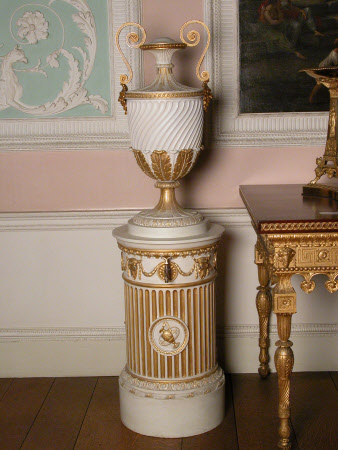Dining room urn and pedestal
Robert Adam (Kirkcaldy 1728 - London 1792)
Category
Furniture
Date
circa 1767
Materials
Paint, gilding, wood, lead, metal
Measurements
125 cm (Height); 41 cm (Diameter)
Place of origin
Berkeley Square
Order this imageCollection
Osterley Park and House, London
NT 771750.1
Summary
One of a pair of dining room pedestals and urns, made of carved, painted and gilded wood, designed by Robert Adam (1729-92) in 1767 and attributed to John Linnell (1729-96). The urn topped by a lid with guilloche border and lined with lead and with a spiral-fluted body, carved with acanthus leaves and fitted with a pair of boldly scrolling handles with satr mask backplates. The urn fitted to the interior with a pipe terminating in a spigot or tap of gilded metal to the pedestal, which has a frieze carved with alternating ox skulls (bucrania) and floral medallions joined by garlands of husks. The body of the pedestal fluted and fitted with a hinged door centred by a medallion of an urn (lekythos) and a shield. The plinth base with two upper mouldings carved with raffled leaves and a riband.
Full description
Three pieces of surviving written evidence testify to the involvement at Osterley of the carvers and cabinet-makers William Linnell (d. 1763) and his son John (1728-96): the appearance of a ‘Mr Child’ listed amongst the debtors of William Linnell on his death in 1763; a bill from John Linnell to Mrs Sarah Child (d. 1793) relating to work done by the firm in 1782-3; and the chance reference to these urns and pedestals in a bill submitted by John Linnell to another client, William Drake Esq. of Shardeloes, Buckinghamshire, for ‘2 coopers the tops in the form of vases and large brass handles like Mr Childs [sic]…’ Adam’s surviving drawing shows that he offered the Childs two variant designs for these urns and pedestals. The model chosen for Osterley features a spiral-fluted urn, and a pedestal decorated with bucrania (ox skulls) and lekythos (single-handled ewers or urns), both staples of neo-Classical ornament in England. These pieces of furniture were not intended to be solely ornamental: this urn is lead-lined to hold water (probably for rinsing glasses) dispensed by the tap fitted to its pedestal, which in turn would probably have held either a chamber-pot or a mahogany pail. Drake – and, presumably, the Childs – paid £30 for his pair of urns and their accompanying pedestals; a mahogany pail with brass handles cost an additional £1 9s. They were described in the inventory taken at Osterley in 1782 as 'Two very elegant Pedestals and vases carved and Japanned White and Gold' and in the inventory taken in 1871 as a 'Pair of Carved White and Gold pedestals and Vases w[ith] lead lined Cisterns and sliding cupboards'.
Makers and roles
Robert Adam (Kirkcaldy 1728 - London 1792), designer John Linnell (1729 - 1796), cabinetmaker
